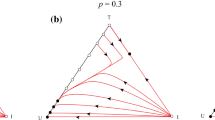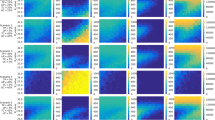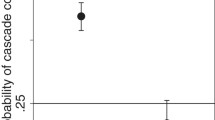Abstract
What if living in a relatively trustworthy society was sufficient to blindly trust strangers? In this paper we interpret generalized trust as a learning process and analyse the trust game paradox in light of the replicator dynamics. Given that trust inevitably implies doubts about others, we assume incomplete information and study the dynamics of trust in buyer-supplier purchase transactions. Considering a world made of “good” and “bad” suppliers, we show that the trust game admits a unique evolutionarily stable strategy: buyers may trust strangers if it is not too risky to do so. Examining the situation where some players may play either as trustor or as trustee we show that this result is robust.

Similar content being viewed by others
Notes
Note that many contributions study determinants of generalized trust by focusing on the correlation between generalized trust and variables such as democracy (e.g., Bjornskov 2006), political participation (e.g., Montoro and Puchades 2010), professional associations (e.g., Sabatini 2009), economic growth (e.g., Knack and Keefer 1997), income inequality (e.g., Uslaner 2002; Yamamura 2008), education (e.g., Knack and Zak 2002), ethnicity (e.g., Holm and Danielson 2005) or religions (e.g., La Porta et al. 1997). They offer detailed and precise estimates of possible determinants of trust and should not be envisioned as competing but complementing our approach.
Fehr (2009), in a synthesis of leading achievements in neuro-economics and behavioural economics, shows that trust may be explained as the conjunction of three elements: beliefs about other people’s trustworthiness, risk preferences, and social preferences (in particular, betrayal aversion).
To justify this modelling choice, recall that Schlag (1998) argues that the limiting case of a learning process that depends on imitation yields the replicator dynamics. Erev and Roth (1998) show that some of the learning models in the psychology literature are approximations of the replicator dynamics model.
We are not interested in this paper on the evolution of trustworthiness. Trustworthiness could spread in a population as a result of learning or of evolutionary pressure. This question will be analysed later in this research project.
For readability purpose we assume supplier is a he and buyer is a she.
From an evolutionary perspective, agents are identified with a strategy, and the relative frequency of a strategy within the population is the proportion of agents that adopt it.
Note that this setting is more general than the usual repeated games because updating belief is not exogenous.
Several authors define alternative learning models, but alternative adaptation rules lead inexorably towards the replicator dynamics (see among others Gale et al. 1995; Björnested and Weibull 1996). The axiomatic of the learning rules follows this trend by determining the conditions that induce the replicator dynamics (Börgers and Sarin 1997); the axioms that are introduced define the functional form of a desirable learning rule. Schlag (1998) is the only one that proposes a derivation of the replicator dynamics on the basis of an individual behaviour chosen optimally.
Note that for asymmetric games, Selten (1983, 1988) proposed the more general concept of limit evolutionarily stable strategy (LESS). The LESS reflects the idea that the equilibrium strategy may be seen as the limit of ESS for close perturbed games. In these perturbed games, admissible strategies may be required to play some actions with arbitrarily small probability. We use to study the LESS of a game when there is no ESS. This is not the case in our model.
See also the discussion of Fehr (2009) on the self-reinforcing aspect of trust and trustworthiness. According to this author “the empirical evidence suggests that trust can be self-reinforcing” (p. 261).
References
Ahn TK, Esarey J (2008) A dynamic model of generalizad social trust. J Theor Polit 20(2):157–180
Alesina A, La Ferrara E (2000) Participation in heterogeneous communities. Q J Econ 115:847–904
Berg J, Dickhaut J, McCabe K (1995) Trust, reciprocity, and social history. Gam Econ Behav 10:122–142
Bicchieri C, Duffy J, Tolle G (2004) Trust among strangers. Philos Sci 71:1–34
Björnested J, Weibull J (1996) Nash equilibrium and evolution by imitation. In: Arrow K, Colombatto E, Perlman M, Schmidt C (eds) The rational foundations of economic behaviour. MacMillan, London, pp 155–171
Bjornskov C (2006) Determinants of generalized trust: a cross vountry comparison. Public Choice 130:1–21
Börgers T, Sarin R (1997) Learning through reinforcement and replicator dynamics. J Econ Theo 77:1–14
Bower AG, Garber S, Watson JC (1996) Learning about a population of agents and the evolution of trust and cooperation. Int J Ind Organ 15:165–190
Bravo G, Tamborino L (2008) The evolution of trust in non-simultaneous exchange situations. Ration Soc 20:85–113
Camerer C, Weigelt K (1988) Experimental tests of a sequential equilibrium reputational model. Econometrica 56:1–36
Cochard F, Van Nguyen P, Willinger M (2004) Trusting behavior in a repeated investment game. J Econ Behav Organ 55:31–44
Cook K, Cooper R (2003) Experimental studies of cooperation, trust and social exchange. In: Ostrom E, Walker J (eds) Trust and reciprocity: interdisciplinary lessons from experimental research. Russell Sage Foundation, New York, pp 209–244
Cox C (2004) How to identify trust and reciprocity. Gam Econ Behav 46:260–281
Deutsch M (1958) Trust and suspicion. J Confl Resolut 2:265–279
Dubois D, Willinger M (2007) The role of players’ identification in the population on the trusting and the trustworthy behaviour: an experimental investigation. Working paper Lameta Montpellier
Engelmann D, Normann HT (2010) Maximum effort in the minimum effort game. Exp Econ 13:249–259
Erev I, Roth AE (1998) Predicting how people play games: reinforcement learning in experimental games with unique, mixed strategy equilibria. Am Econ Rev 88:848–881
Fehr E (2009) On the economics and biology of trust. J Europ Eco Ass 7:235–266
Fehr E, Schmidt M (1999) A theory of fairness, competition and cooperation. Q J Econ 114:817–868
Fukuyama F (1995) Trust: the social virtues and the creation of prosperity. Free press, New York
Gale J, Binmore K, Samuelson L (1995) Learning to be imperfect: the ultimatum game. Gam Econ Behav 8:56–90
Gardner R, Morris MR (1991) The evolutionary stability of bluffing in a class of extensive form games. In: Selten R (ed) Game equilibrium models, vol. 1: evolution and game dynamics. Springer, Berlin, pp 182–194
Gautschi T (1999) A hostage trust game with incomplete information and fairness considerations of the trustee. Working Paper, Utrecht University, Department of Sociology
Gintis H (2000) Game theory evolving. Princeton University Press, Princeton
Glaeser EL, Laibson DI, Scheinkman JA, Soutter CL (2000) Measuring trust. Q J Econ 115:811–846
Granovetter M (1985) Economic action and social structure: the problem of embeddedness. Am J Sociol 91:481–510
Güth W, Kliemt H (1994) Competition or co-operation: on the evolutionary economics of trust, exploitation and moral attitudes. Metroeconomica 45:155–187
Güth W, Kliemt H, Peleg B (2000) Co-evolution of preferences and information in simple games of trust. Ger Econ Rev 1:83–110
Holm JJ, Danielson A (2005) Tropic trust versus nordic trust: experimental evidence from Tanzania and Sweden. Econ J 115:505–532
Kandori M (1992) Social norms and community enforcement. Rev Econ Stud 59:63–80
Karlan DS (2005) Using experimental economics to measure social capital and predict financial decisions. Am Econ Rev 95:1688–1699
Katz HA, Rotter JB (1969) Interpersonal trust scores of college students and their parents. Child Dev 40:657–661
Knack S, Keefer P (1997) Does social capital have an economic payo? A cross-country investigation. Q J Econ 112:1251–1288
Knack S, Zak PJ (2002) Building trust: public policy, interpersonal trust, and economic development. Sup Court Econ Rev 10:91–107
Kreps D (1990) Corporate culture and economic theory. In: Alt JE, Shepsle KA (eds) Perspectives on positive political economy. Cambridge University Press, Cambridge, pp 90–143
Kreps DM (1993) Game theory and economic modeling, 4th edn. Clarendon Press, Oxford
La Porta R, Lopez-de-Silanes F, Shleifer A, Vishny RW (1997) Trust in large organizations. Am Econ Rev 87:333–338
Lahno B (2004) Is trust the result of bayesian learning? In: Behnke J, Plümper T, Burth HP (eds) Jahrbuch für Handlungs- und Entscheidungstheorie, Band 3. VS-Verl., Wiesbaden, pp 47–68
Maynard Smith J, Price GR (1973) The logic of animal conflicts. Nature 246:15–18
Montoro JD, Puchades M (2010) Social capital and political participation. Econ Bull 30:3329–3347
Nooteboom B (2002) Trust: forms, functions, foundations, failures and figures. Edward Elgar, Cheltenham UK
Nooteboom B (2010) The dynamics of trust: communication, action and third parties. Mimeo Tilburg
Ortmann A, Fitzgerald J, Boeing C (2000) Trust, reciprocity, and social history: a re-examination. Exp Econ 3:81–100
Putnam RD (1993) Making democracy work: civic traditions in modern Italy. Princeton University Press, Princeton
Putnam RD (2000) Bowling alone: the collapse and revival of American community. Simon and Schuster, New York
Sabatini F (2009) The relationship between trust and networks. An exploratory empirical analysis. Econ Bull 29:661–672
Schlag KH (1998) Why imitate, and if so, how? A bounded rationality approach to multi-armed bandits. J Econ Theo 78:127–159
Selten R (1980) A note on evolutionarily stable strategies in asymmetric animal conflicts. J Theor Biol 84:93–101
Selten R (1983) Evolutionary stability in extensive two-agent games. Math Soc Sci 5:269–363
Selten R (1988) Evolutionary stability in extensive two-agent games: correction and further development. Math Soc Sci 16:223–266
Snijders C, Keren G (1999) Determinants of trust. In: Budescu DV, Erev I, Zwick R (eds) Games and human behavior. Lawrence Erlbaum, Mahwah, pp 355–385
Taylor P, Jonker L (1978) Evolutionarily stable strategies and game dynamics. Math Biosci 40:145–156
Tsuji R, Harihara M (2002) Urban and rural social networks and general trust. In: Proceedings of the 43rd JSSP Conference (Japan), pp 114–115
Uslaner EM (2002) The moral foundations of trust. Cambridge University Press, New York
Uslaner EM (2004) Where you stand depends on where your grand parents sat: the inheritability of generalized trust. Mimeo, University of Maryland
Yamagishi T, Cook KS, Watabe M (1998) Uncertainty, trust and commitment formation in the United States and Japan. Am J Sociol 104:165–194
Yamamura E (2008) Determinants of trust in a racially homogeneous society. Econ Bull 26(1):1–9
Yosano A, Hayashi N (2005) Social stratification, intermediary groups and creation of trustfulness. Sociol Theo Meth 20:27–44
Zeeman EC (1980) Population dynamics from game theory. In: Nitecki Z, Robinson C (eds) Global theory of dynamical systems, lecture notes in mathematics, vol 819. Springer, Berlin, pp 471–497
Zucker LG (1986) Production of trust: institutional sources of economic structure. Res Organ Behav 8:53–111
Author information
Authors and Affiliations
Corresponding author
Appendix
Appendix
Proof of Proposition 1
The Jacobian of the replicator dynamics at any point r = (p1, p2G, p2B) can be expressed as follows:
and therefore:
According to definition (1), in order to characterize the ESS we should study the eigenvalues of the matrix J in each of the 8 points that are candidates.
Let r* = (1,1,1). The Jacobian is:
The eigenvalues are: –c1, –(c2 + ε – b2), –(c2 + β – b2). They are all negative (which shows that (1,1,1) is hyperbolically stable) if:
The condition on the gains of 2B (i.e. (c2 + β – b2) > 0) contradicts one of the assumption of the trust game and we deduce that (1,1,1) is not an ESS. In the same manner, we show that (1,0,1) and (1,0,0) are also not ESS.
We focus now on (1,1,0), (0,1,1), (0,1,0), (0,0,1) and (0,0,0). For (1,1,0), we have:
and this point is an ESS because conditions on the gains of the two types of player 2 do not contradict the assumptions of the model. We have: c2 + ε − b2 > 0 and c2 + β − b2 < 0 and these conditions are verified for:
Regarding (0,1,1), (0,1,0), (0,0,1) and (0,0,0), we obtain respectively:
For each of those cases, 0 is an eigenvalue and they are not ESS which concludes the proof.□
Proof of Proposition 2
We proceed as in proposition 1, the difference being that now there is a third type of player that may both play as buyer or seller. We denote by p3G (respectively p3B) the proportion of players 3G (respectively 3B) choosing T when buying and choosing H when selling. The complement 1 − p3G (respectively 1 − p3B) is the proportion of players 3G (respectively 3B) choosing M when buying and E when selling.
We start determine the replication equation associated to the behaviour of player 1. If she matches a player 2, her expected payoff is pp2Gc1 + p(1 − p2G)b1 + (1 − p)p2Bc1 + (1 − p)(1 − p2B)b1 and if she matches a player 3, her expected payoff is pp3Gc1 + p(1 − p3G)b1 + (1 − p)p3Bc1 + (1 − p)(1 − p3B)b1. Since player 1 matches a player 2 with probability 1/2 and a player 3 with a probability 1/2, her expected payoff is:
The average gain of all 1-players is \(\pi_1^{\rm m} ={\rm p}_1\pi_1 +(1-{\rm p}_1 )0\) and the growth rate of p1 is \(\dot{\rm p}_1 ={\rm p}_1 (1-{\rm p}_1 )\pi_1 ={\rm p}_1 (1-{\rm p}_1 )\frac{1}{2}[{\rm p}({\rm p}_{2{\rm G}} +{\rm p}_{3{\rm G}} ){\rm c}_1 +{\rm p}(2-{\rm p}_{2{\rm G}} -{\rm p}_{3{\rm G}} )\mbox{b}_1 +(1-{\rm p})({\rm p}_{2{\rm B}} +{\rm p}_{3{\rm B}}){\rm c}_1 +(1-{\rm p})(2-{\rm p}_{2{\rm B}} +{\rm p}_{3{\rm B}} ){\rm b}_1 ]\).
Consider now player 2G. If he matches with a player 1, his expected payoff is p1 (c1 + ε). If he matches with a player 3, his expected payoff is pp3G (c2 + ε) + (1 − p)p3B(c2 + ε). Again, given player 2G matches with a player 1 with a probability 1/2 and with a player 3 with a probability 1/2, his expected gain is:
The average gain of all 2G-players is:
and the growth rate of p2G is:
Similarly, we deduce that:
Finally, consider a hybrid player 3G. If acting as a buyer, his expected payoff is pp2Gc1 + p(1 − p2G)b1 + (1 − p)p2Bc1 + (1 − p)(1 − p2B)b1 and if acting as a supplier, his expected payoff is p1 (c2 + ε). Total expected gain is then:
and we deduce:
The growth rate of p3G is:
Similarly, we obtain:
The Jacobian of the coefficient matrix of the above dynamics is the following:
For point r ∗ = (1,1,0,1,1), we obtain:
And we deduce that the eigenvalues are negatives if:
By assumption, Eqs. 3 and 4 are always true and Eqs. 2, 5 and 6 lead to the following inequality:
Given the assumption of the model, we deduce that (1,1,0,1,1) is an ESS when:
For point r* = (1,1,0,1,0), the Jacobian is:
and we deduce that the eigenvalues are negatives if:
Inequalities (8) and (9) are always true and we deduce from Eqs. 7, 10 and 11 that:
Given − b1 > b2 − c2 − ε − b1, we deduce:
which is the condition for (1,1,0,1,0) to be an ESS. End of the proof. □
Rights and permissions
About this article
Cite this article
Courtois, P., Tazdaït, T. Learning to trust strangers: an evolutionary perspective. J Evol Econ 22, 367–383 (2012). https://doi.org/10.1007/s00191-011-0247-z
Published:
Issue Date:
DOI: https://doi.org/10.1007/s00191-011-0247-z




